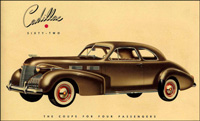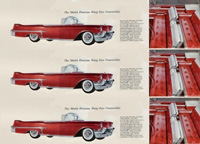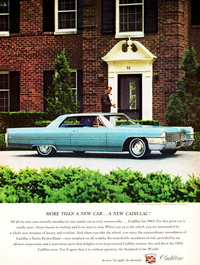1937-1976 Cadillac Series 62, 65, Calais
Cadillac Series 62
 The Series 62 Cadillac started in 1940, but its origins go back to 1939 and the Series 61, which itself was the 60 Series in 1938. These were the “entry-level” Cadillacs, usually the least expensive, but still a Cadillac for sure. These coalesced into the Series 62. The Series 62 usually took in the bulk of body styles you would normally associate a main line car manufacturer to produce, leaving the longer/larger sedans, limousines, and specialty commercial products to other, and more exclusive and luxurious series within Cadillac.
The Series 62 Cadillac started in 1940, but its origins go back to 1939 and the Series 61, which itself was the 60 Series in 1938. These were the “entry-level” Cadillacs, usually the least expensive, but still a Cadillac for sure. These coalesced into the Series 62. The Series 62 usually took in the bulk of body styles you would normally associate a main line car manufacturer to produce, leaving the longer/larger sedans, limousines, and specialty commercial products to other, and more exclusive and luxurious series within Cadillac.
By 1940 the Series 62 was built on the corporate GM C-body, the largest platform available within the GM hierarchy. This was the soap bar era with round, torpedo-like shapes typical of what we think of the streamline era. Powered by Cadillac’s L-head V8, output was in the 150hp range. In 1942 the C-body was revised with more square-shouldered design features and fastback “Sedanette” bodies. With 1942 production shortened for the war, once manufacturing resumed in 1945 as 1946 Cadillacs, the design and mechanicals were carried over with little change. By 1947 Series 62 accounted for 65-percent of all Cadillac sales.
 The new third generation 62s arrived in 1948. Lower, wider and still fairly round, they were a lot more modern looking than their predecessors. Series 62 got the first industry game-changing overhead valve V8 and also the first hardtop “Coupe DeVille” in 1949, and Cadillac steamrolled through the luxury segment never looking back. The last year of this generation, 1953, saw the expensive and exclusive “Eldorado” convertible. Eldorados would be a unique model within the Series 62 for years.
The new third generation 62s arrived in 1948. Lower, wider and still fairly round, they were a lot more modern looking than their predecessors. Series 62 got the first industry game-changing overhead valve V8 and also the first hardtop “Coupe DeVille” in 1949, and Cadillac steamrolled through the luxury segment never looking back. The last year of this generation, 1953, saw the expensive and exclusive “Eldorado” convertible. Eldorados would be a unique model within the Series 62 for years.
The flatter, longer, wider fourth gen Series 62 debuted in 1954 further refining the Cadillac look, and luxury itself in America. These were the classic Cadillacs with features that forever defined 1950s excess and exuberance. Tail fins, massive bumpers with bullets and grille guards, wide egg crate grilles, and large bodies with lots of chrome and glass. Inside many color and material options combined with luxurious seating and appointments offered more than any other luxury car on the market.
Trim, grilles and details would change from year to year, with the basic design styling relatively the same through this generation that ran three years.
 The 1957-58 Cadillacs played up on the finned, chromed, flashy American car design established by the fourth generation. The Eldorado Seville in 1957 and 1958 Biarritz differentiated from run of the mill Cadillacs with unique front ends and rear sheet metal from the doors back. They were available as both a hardtop and convertible. The Eldorado Broughams from these years were part of the Series 70 classification and not Series 62. 1958 also saw the introduction of the trouble-prone air suspension system.
The 1957-58 Cadillacs played up on the finned, chromed, flashy American car design established by the fourth generation. The Eldorado Seville in 1957 and 1958 Biarritz differentiated from run of the mill Cadillacs with unique front ends and rear sheet metal from the doors back. They were available as both a hardtop and convertible. The Eldorado Broughams from these years were part of the Series 70 classification and not Series 62. 1958 also saw the introduction of the trouble-prone air suspension system.
Considered some of the most extreme-styled cars ever were the fifth generation 1959-60 Cadillac. The Series 62 was split up and renamed Series 6200 in 1959. Deville and Eldorado were broken out of the Series 62/6200 to become their own Series 6300/6400. Styling, though excessive, was clean with almost no trim and large, blade-like fins sporting twin bullet taillights. Fine, fussy grilles were featured in both the front and rear between the trunk and bumper. 1960’s version cleaned up the design even more with smaller fins without taillights and reduced bumper mass.
 1961 brought a completely new Cadillac featuring sculptured styling but clean—the era of big V8s, air conditioning, and floating cloud handling was in full force. The emphasis of width was seen in the styling of both the front and rear. The sculpturing helped to reduce visual body mass. Tops started to lose their light, airy design with C-pillars becoming heavier giving a more formal look. 1962 continued with this body but restyled the rear with vertical taillights ending the rear fenders surrounded in a chrome bumper.
1961 brought a completely new Cadillac featuring sculptured styling but clean—the era of big V8s, air conditioning, and floating cloud handling was in full force. The emphasis of width was seen in the styling of both the front and rear. The sculpturing helped to reduce visual body mass. Tops started to lose their light, airy design with C-pillars becoming heavier giving a more formal look. 1962 continued with this body but restyled the rear with vertical taillights ending the rear fenders surrounded in a chrome bumper.
The 1963-64 Cadillacs reverted back to cleaner bodies without sculpturing, continuing the trends of less crown, flatter surfaces, while maintaining the fins and massive front ends with wide egg crate grilles. The last Series 6200/62 was produced in 1964. In 1965 it was renamed “Calais” and received the new GM C-body design which was more lean and shear than previous Cadillacs.
1965-76 Cadillac Calais
 The Cadillac Calais was the base or entry-level model Cadillac starting in 1965. All of General Motors products were made up of different price points starting with Chevrolet as the base division, ending at the top with Cadillac, and even within each division there was a level or tier. For years the Lasalle bridged the gap between Buick and Cadillac, until it was discontinued in 1940. From there the Series 62 Cadillac became that bridge, as the cheapest Cadillac you could buy. In 1965 the name was changed to the more glamorous-sounding Calais.
The Cadillac Calais was the base or entry-level model Cadillac starting in 1965. All of General Motors products were made up of different price points starting with Chevrolet as the base division, ending at the top with Cadillac, and even within each division there was a level or tier. For years the Lasalle bridged the gap between Buick and Cadillac, until it was discontinued in 1940. From there the Series 62 Cadillac became that bridge, as the cheapest Cadillac you could buy. In 1965 the name was changed to the more glamorous-sounding Calais.
All Cadillacs in 1965 received the new GM C-body design, which was leaner and shear than previous Cadillacs. Stacked headlights, a Cadillac theme for the next few years, appeared for the first time. Still featuring rear fins, they were more integrated into the body than any previous attempt. Bodies were flatter with hard facets and crisp, clean lines. Bumper end-caps housed the taillights and finished off the fenders. A coupe, four-door sedan and hardtop were available in the Calais line. The 429ci engine was carried over from 1964.
Though the base Cadillac, standard equipment included full power, cornering lights, front and rear seat belts, windshield washers and dual-speed wipers, remote outside mirrors, courtesy lights in the glove box, trunk, and for rear passengers, and more. Extensively restyled in 1967, engine size was up to almost 500ci. With a curb weight of 5000-pounds, Cadillacs were not lithe or lean. A Calais coupe was almost $400 less than a Coupe DeVille, coming in at $5040 list price. The new Eldorado was almost $1300 more than the Calais.
 By 1969 the Calais was restyled to pick up cues from the landmark 1967 Eldorado design. Both the rear fenders and hood were each lengthened over two-inches, and the top was squared up for a more formal look. Now available only as a hardtop four-door sedan and coupe, Cadillac sold over 10,000 Calais in both 1969 and 1970.
By 1969 the Calais was restyled to pick up cues from the landmark 1967 Eldorado design. Both the rear fenders and hood were each lengthened over two-inches, and the top was squared up for a more formal look. Now available only as a hardtop four-door sedan and coupe, Cadillac sold over 10,000 Calais in both 1969 and 1970.
In 1971 the last new design in the series arrived. The wheelbase had extended to 130-inches. Low, wide grilles, 500ci engines, and massive hoods, interiors and trunks created one of the largest Cadillacs ever built. With a corporate-wide push to meet federal emissions and safety regulations, development monies were cut back for annual styling changes, so the 1972 Calais saw little exterior changes. In 1973 energy-absorbing bumpers required fascia revisions, but other than engine detuning as emissions regulations took effect, there were only minor visual changes. Restyled for 1974, the top received large opera windows and an egg crate grille. Inside the Calais received a curved dash featuring a digital clock. Sales were half of what they were just two years previous, with a total of roughly 6000 coupes and sedans sold.
 1975 saw the newly approved rectangular headlights incorporated into the front end. By mid-year electronic fuel injection was available for the first time. While Cadillac interiors were always luxurious, around this time a wide assortment of materials were available that included plaids, plush velour, knits, and 11 choices of leather.
1975 saw the newly approved rectangular headlights incorporated into the front end. By mid-year electronic fuel injection was available for the first time. While Cadillac interiors were always luxurious, around this time a wide assortment of materials were available that included plaids, plush velour, knits, and 11 choices of leather.
In a move to simplify identities and models within Cadillac and to shore up marketing budgets the Calais was discontinued in 1976. Cadillac would simplify their series with DeVille as the entry level Cadillac, followed by Fleetwood, Brougham, and the sporting Eldorado coupe.
Series 65
 Positioned between the largest Lasalle and below the Cadillac Series 75, the first 1937 Series 65 was based on the same GM C-body as the Series 75 Fleetwood, but priced below it. Available only as a four-door sedan, it was a longer, larger Cadillac than the Series 60. In 1938 it featured the same front end design as the Series 75 Fleetwood sedan. This was the last year it was available.
Positioned between the largest Lasalle and below the Cadillac Series 75, the first 1937 Series 65 was based on the same GM C-body as the Series 75 Fleetwood, but priced below it. Available only as a four-door sedan, it was a longer, larger Cadillac than the Series 60. In 1938 it featured the same front end design as the Series 75 Fleetwood sedan. This was the last year it was available.